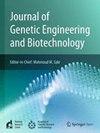巴士拉市乳腺炎奶牛多药耐药木糖葡萄球菌NM36的全基因组序列和比较基因组学分析
IF 3.5
Q3 Biochemistry, Genetics and Molecular Biology
Journal of Genetic Engineering and Biotechnology
Pub Date : 2023-12-01
DOI:10.1186/s43141-023-00606-6
引用次数: 0
摘要
背景:木糖葡萄球菌是一种凝固酶阴性,革兰氏阳性的球菌,存在于环境中,是动物皮肤和粘膜表面的共生生物。尽管木糖葡萄球菌被认为是一种非致病性细菌,但一些研究已经将木糖葡萄球菌与动物和人类的机会性感染联系起来。在伊拉克巴士拉省对引起乳腺炎的病原体进行调查期间,我们从一头患有慢性乳腺炎的奶牛的牛奶样本中发现了一种耐抗生素的木葡萄球菌NM36菌株。除了强健的生物膜形成外,还发现了多种抗生素耐药表型。为了进一步了解这些表型的遗传背景,对木糖酵母NM36的全基因组进行了分析。结果:基因组由单个环状2,668,086个碱基对染色体组成,含G + C 32.8%。基因组中有2454个蛋白质编码序列,4个核糖体RNA (rRNA)基因和50个转移RNA (tRNA)基因。此外,通过检索具有代表性的参考基因组序列数据,对遗传变异进行了研究。因此,进行单核苷酸多态性分析,发现有46,610个单核苷酸多态性(snp), 523个插入,551个缺失。为了克服抗生素,木葡萄球菌NM36已从几个类群和家族中获得了几个抗生素耐药基因。病理系统资源整合中心(PATRIC)的基因组注释服务和使用子系统技术的快速注释(RAST)注释服务器显示,存在多种抗生素耐药元件,包括抗生素失活酶(BlaZ家族,FosB),抗生素耐药基因簇(TcaB, TcaB2, TcaR),甲氧西林耐药相关蛋白(LytH, FmtA, FemC, HmrB, HmrA), TetR家族转录调控因子,和外排泵赋予抗生素耐药性(NorA)。此外,我们对NM36菌株的生物膜和群体感应元件进行了调查和分类,发现其具有多个生物膜调控亚群,证实了其致病性。结论:这些发现需要在处理凝固酶阴性葡萄球菌时重新评估微生物和临床干预措施,特别是在与公共卫生有关的研究背景下。据我们所知,这是第一次在伊拉克对木葡萄球菌的整个基因组进行测序。本文章由计算机程序翻译,如有差异,请以英文原文为准。
Whole genome sequence and comparative genomics analysis of multidrug-resistant Staphylococcus xylosus NM36 isolated from a cow with mastitis in Basrah city
Background
Staphylococcus xylosus is a coagulase-negative, gram-positive coccus that is found in the environment and as a commensal organism on the skin and mucosal surfaces of animals. Despite the fact that S. xylosus is considered a nonpathogenic bacterium, several studies have linked S. xylosus to opportunistic infections in both animals and humans. During an investigation of mastitis-causing agents in the governorate of Basrah, Iraq, we identified an antibiotic-resistant strain of S. xylosus NM36 from a milk sample from a cow with chronic mastitis. In addition to robust biofilm formation, multiple antibiotic resistance phenotypes were found. To further understand the genetic background for these phenotypes, the full genome of S. xylosus NM36 was analyzed.
Results
The genome consisted of a single circular 2,668,086 base pairs chromosome containing 32.8% G + C. There were 2454 protein-coding sequences, 4 ribosomal RNA (rRNA) genes, and 50 transfer RNA (tRNA) genes in the genome. In addition, genetic variation was studied by searching sequence data against a representative reference genome. Consequently, single-nucleotide polymorphism analysis was conducted and showed that there were 46,610 single-nucleotide polymorphisms (SNPs), 523 insertions, and 551 deletions. In order to overcome antibiotics, S. xylosus NM36 had been armed with several antibiotic resistance genes from several groups and families. The genome annotation service in PathoSystems Resource Integration Center (PATRIC) and Rapid Annotation using Subsystem Technology (RAST) annotation servers showed that there are multiple antimicrobial resistance elements, including antibiotic inactivation enzymes (BlaZ family, FosB), antibiotic resistance gene clusters (TcaB, TcaB2, TcaR), proteins involved in methicillin resistance (LytH, FmtA, FemC, HmrB, HmrA), TetR family transcriptional regulators, and efflux pumps conferring antibiotic resistance (NorA). In addition, we investigated and categorized the biofilm and quorum-sensing elements of the NM36 strain and found that it has multiple subsets of biofilm regulators, confirming its pathogenic nature.
Conclusions
These findings necessitate a reevaluation of microbial and clinical interventions when dealing with coagulase-negative staphylococci, particularly in the context of studies pertaining to public health. This is the first time, to our knowledge, that the entire genome of S. xylosus has been sequenced in Iraq.
求助全文
通过发布文献求助,成功后即可免费获取论文全文。
去求助
来源期刊

Journal of Genetic Engineering and Biotechnology
Biochemistry, Genetics and Molecular Biology-Biotechnology
CiteScore
5.70
自引率
5.70%
发文量
159
审稿时长
16 weeks
期刊介绍:
Journal of genetic engineering and biotechnology is devoted to rapid publication of full-length research papers that leads to significant contribution in advancing knowledge in genetic engineering and biotechnology and provide novel perspectives in this research area. JGEB includes all major themes related to genetic engineering and recombinant DNA. The area of interest of JGEB includes but not restricted to: •Plant genetics •Animal genetics •Bacterial enzymes •Agricultural Biotechnology, •Biochemistry, •Biophysics, •Bioinformatics, •Environmental Biotechnology, •Industrial Biotechnology, •Microbial biotechnology, •Medical Biotechnology, •Bioenergy, Biosafety, •Biosecurity, •Bioethics, •GMOS, •Genomic, •Proteomic JGEB accepts
 求助内容:
求助内容: 应助结果提醒方式:
应助结果提醒方式:


